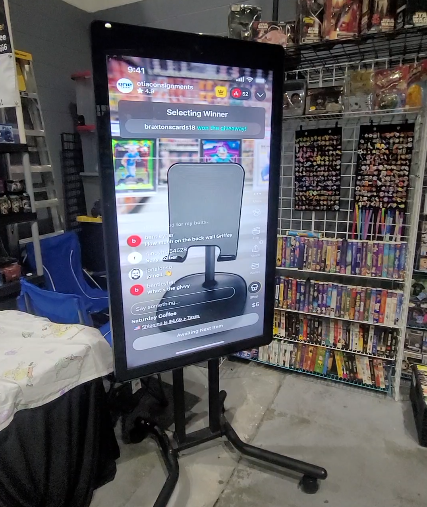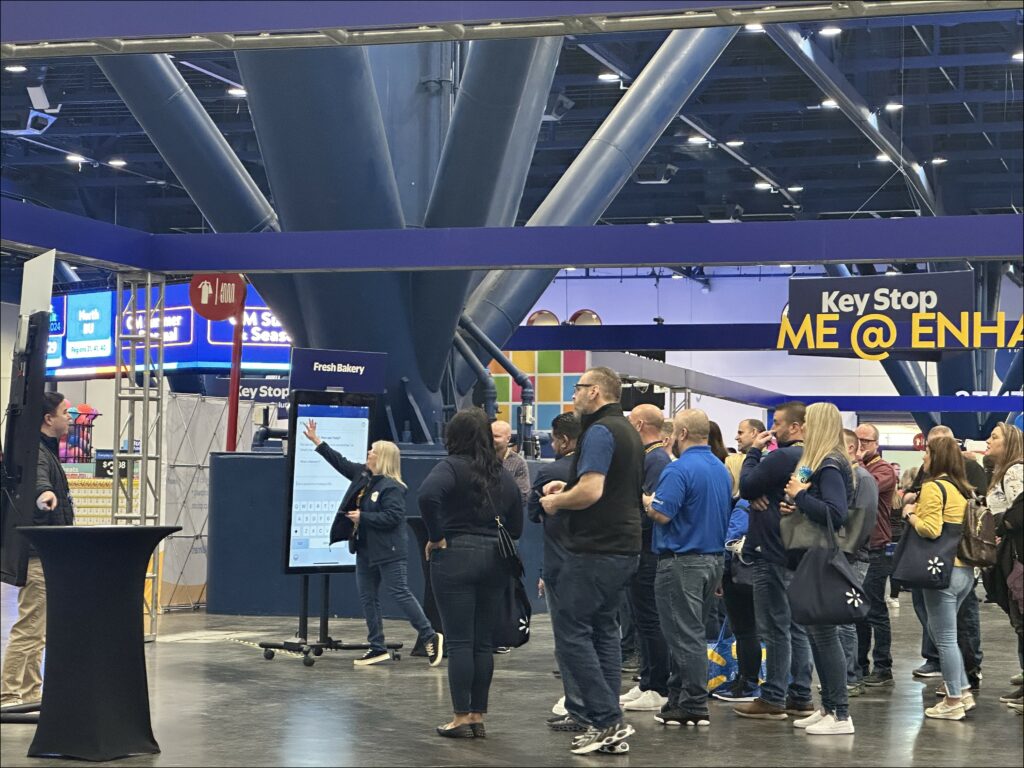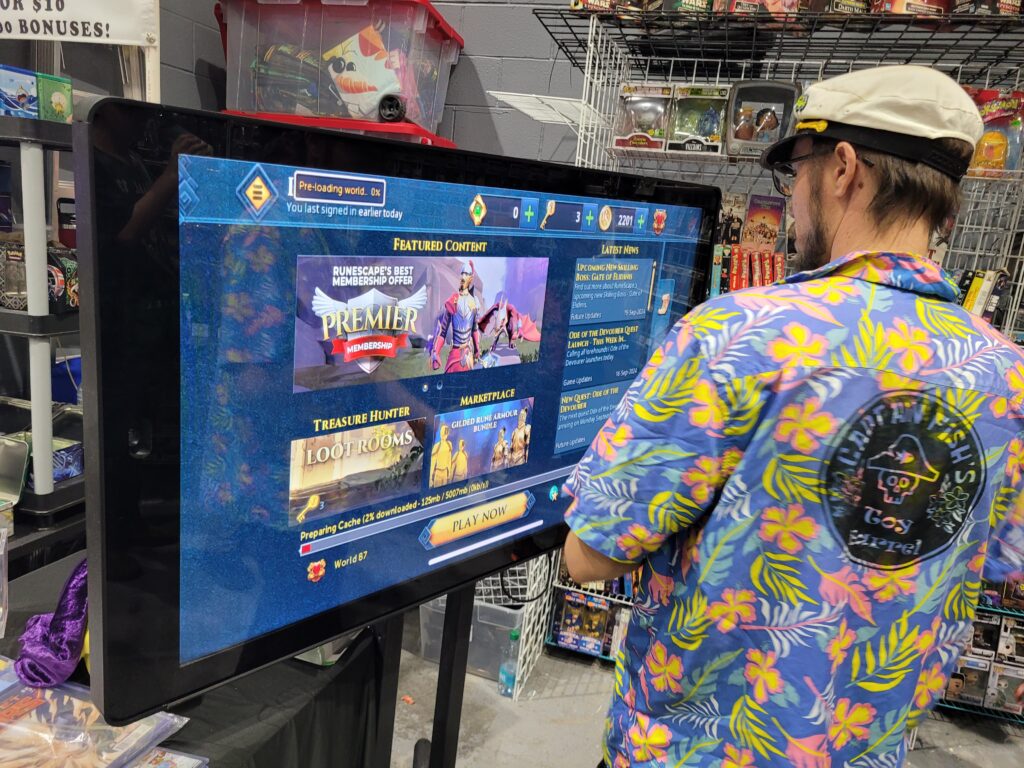Are you preparing for an upcoming trade show and wondering how you can get your booth to attract more engagement and leads? Done strategically, interactive trade show booths are a surefire way to pull curious visitors in. They help your brand stay top of mind with anyone who gets to experience your kiosk on the show floor.
On that note, let’s dig deeper into what makes interactive booths irresistible—one that gets people talking, posting on social media, and sticking around more!
Key Takeaways
- People crave a memorable experience. The most memorable booths invite interaction, not just observation.
- Interactivity works at any budget. Whether it’s a touchscreen quiz or a handmade trade show game, creativity beats cost.
- Psychology drives engagement. Curiosity, competition, and surprise are what stop people in their tracks.
- One great interactive trade show booth idea > five scattered ones. Focus on a single, strong hook that reflects your brand.
- Measure what matters. Beyond booth traffic, track dwell time, lead quality, and post-show impact.
- Design for after the show, too. Social sharing, content follow-ups, and ongoing campaigns turn one moment into momentum.
The Power of Interactivity at Trade Shows
Plenty of booths on the show floor for attendees to visit and engage with, each one promising “innovation” but delivering… more of the same.
Now imagine the opposite where they pause. Not because someone shoved a flyer into their hands but because something genuinely caught their attention, triggering a spark of “What’s this?”
That’s what interactivity does.
People Don’t Want to Be Sold. They Want to Be Involved.
This is the shift. Today’s trade show booth visitors are not looking to be talked at. They’re looking more to connect. Touch something. Try something. Compete. Laugh. Ask questions and get real answers in the moment.
When your trade booth lets them do exactly that, you stop being just another vendor and start being the one they remember.
Engagement That Feels Natural
The best interactive experiences feel like conversations. They solve a problem. Or they surprise trade show visitors and potential customers in a smart way.
You’re not trying to consciously wow them; what you’re trying to accomplish is meet them where they are and give them something they didn’t expect to find. That’s how real engagement happens.
It’s a Better Follow-Up
When people actively engage with your exhibition booth, they’re giving you insights. From what they touched, what they asked, and what got them to linger. In consequence, now you’re not guessing who to follow up with or what to say. You’ve got context.
That makes your emails smarter, your sales calls easier, and your event ROI way easier to prove to whoever’s watching the budget.
The Psychology Behind Interactive Engagement at Events
People don’t stop at booths because they care about your product (at least not at first). They stop because something in their brain lights up. (Curiosity. Challenge. Play. Recognition.)
That’s what you’re really competing for—not attention, but emotion. And making your trade show booth interactive is how you tap into it.
Curiosity Is a Hardwired Reflex
The brain is constantly scanning for novelty. Anything even slightly different from the noise around it gets flagged: Hey, what’s that? That’s your opening. Interactive booths stand out because they offer something to do instead of something to merely look at.
When a screen invites you to touch it, or a challenge tempts you to compete, it triggers a basic, human instinct: explore.
People Remember What They Experience
A lot of attendees will forget what they heard during their trade show attendance. But many will remember what they did—especially when there’s a little emotion tied to it. It could be a little laughter, a win, or a spark of surprise.
That moment becomes a story they tell later even if they don’t realize it. And when you’re part of their story, they remember your brand and how you made them feel during their visit.
Choice Creates Ownership
When someone chooses to engage—touch a giant iPhone screen, start a fun game, test a product—they feel like they’re in control. It’s not you trying hard to push a message. It’s them pulling information on their own volition.
That creates a sense of ownership that then leads to trust. People trust what they discover for themselves more than what they’re told.
Dopamine Loves a Win
Throw in a quiz, a leaderboard, a prize wheel. Something that gives them a chance to win—and now you’re lighting up the reward centers of the brain. It doesn’t even have to be a big prize. Sometimes, it’s the win itself that feels good. And what feels good gets remembered. Shared. Talked about.
Top 5 Best Trade Show Booth Ideas to Attract Visitors and Increase Engagement
Not all interactivity hits the same. Some tools lure people in with amazing technology. Others win by caving into our need to play, connect, or even just smell something interesting.
The key is choosing the type of experience that fits your brand and your target audience. Here’s a breakdown of what unique trade show booth ideas work (and why).
Digital Engagement Tools: Touchscreens, AR, and VR That Invite Exploration
Whether it’s an interactive product catalog, a build-your-own-solution tool, or a “what type are you?” quiz that they can play by scanning a QR code, these trade show displays let attendees navigate at their own pace. There’s no pressure and no pitch. Just their own curiosity at work.

If you want to go bigger and appeal to the tech-savvy and tech-curious, augmented reality and virtual reality give you a chance to tell your story in interactive 3D.
Let people walk through your product in a virtual space. Show them what your tech looks like on their body, in their building, or inside their workflow. It’s immersive and, when done right, virtually unforgettable.
Physical Games and Competitions: Because Everyone Loves to Win
Put a leaderboard on a screen and suddenly, your booth becomes a lead magnet. A little friendly competition can do wonders. Think: trivia battles, timed product challenges, mini sports games, or spin-to-win wheels.
The prize? Doesn’t have to be grand. People will compete for a sticker if it means beating someone. That dopamine hit is real and your brand gets associated with that little moment of joy.
Participatory Demos: Let Them Use the Product
Telling someone your product is “easy to use” is one thing. Letting them use it and feel that for themselves? Completely different. Hands-on demos make the value click. No buzzwords or over-explaining. Just: Try it. Feel it. See what it does.
This works for software, tools, gear, food—almost anything. Just remember: the more tactile, the better.
Social Media-Integrated Activities: Engagement That Spreads Beyond the Booth
If your booth experience stays in the booth, you’re missing an opportunity.
Add a social twist. Create something people want to post about—an aesthetic photo booth, a quirky quiz result, a digital caricature, a custom trade show giveaway.
Better yet, tie it to a hashtag or real-time booth display wall. When people see their content showing up live, it builds energy and reach. Now your trade show footprint includes the internet!
Sensory Experiences: Go Beyond the Visual
Most booths focus on sight and sound. That’s perfectly fine and works stupendously well. However, you might also want to tap into the lesser-used senses such as smell, which is especially powerful for memory. That could be a branded scent, a coffee bar, a candle giveaway—suddenly, your brand feels different.
Or try touch: textured materials, temperature shifts, vibrations. Practically, anything that creates a feeling beyond just “seeing your logo.” Sensory details don’t have to be loud. They just have to be intentional.
Key Metrics for Measuring Engagement Success
After all the setup, demos, giveaways, and conversations, there comes that moment: the team huddles back in the office and someone asks the question no one wants to answer with guesswork—Were the tens of thousands (or more) in investment worth it?
This is where metrics matter. Not vanity numbers (e.g., how many people walked by). You want to know who engaged, how deeply, and what happens next.
Here’s what to track and why it tells you more than a fishbowl full of business cards ever could.
Dwell Time: How Long Did People Stick Around?

A crowded booth most certainly looks good from afar, but if people only stay for a few seconds, it’s not doing much. Dwell time tells you who paused, explored, and actually got something out of the trade show experience.
Longer dwell time usually means higher interest. And the longer they stay, the more they remember.
Interaction Rates: Who Actually Touched, Tapped, or Tried Something?
It’s less about how many people saw your interactive display and more about how many actually used it. Whether it’s a gigantic touchscreen you rented from Padzilla, product demo, or prize wheel, count the taps, swipes, scans, or plays.
This tells you which activities are drawing people in and which ones are just sitting there looking pretty.
Lead Quality: Are You Collecting People or Potential?
You don’t need a list of 500 people who just wanted a free tote bag. What you want are conversations that went somewhere; people who engaged with your product, asked real questions, maybe even booked a follow-up.
Look at lead scores, notes from the booth team, or segment by activity type. The goal is always quality over quantity.
Conversion from Interaction to Follow-Up
How many people who played the game, took the quiz, or tried the demo actually followed up? Booked a call? Responded to your post-show email?
That’s the number that closes the loop. If your interactive booth was truly effective, it didn’t just entertain—it opened the door to a win-win business relationship.
Social Shares and Hashtag Reach
If your booth activity was shareable, it should show up online. Track mentions, tagged posts, booth selfies, or your event hashtag. It doesn’t have to go viral (though that’s a huge bonus). What’s important is extending your booth’s impact beyond the physical space.
Even a handful of well-tagged posts can put your brand in front of people who never set foot onto the trade show floor.
Case Studies of Successful Interactive Booth Designs
You can talk strategy all day—but nothing beats seeing how it plays out in the wild.
Here are two standout examples of brands that showed how it’s done by relying on the power of interactive interaction that made people stop, stay, and share.
Case Study: Citizens Bank’s Innovative Photo Booth
At a packed trade show where most booths were competing for glances, Citizens Bank found a way to connect. Knowing that passive tactics like business card bowls were no longer cutting it as it used to, they teamed up with OutSnapped to build a green screen photo booth experience. Complete with iconic Boston backdrops.
Resultingly, nearly every attendee who stopped by ended up participating. Over four days, the booth logged 355 sessions, 89 warm leads per day, and hundreds of photo shares across social media outlets. It worked because people got involved, had fun, and walked away with something worth remembering (and sharing).
In essence, Citizens Bank transformed its booth into a magnet for engagement and meaningful data capture; a perfect example of how interactivity turns foot traffic into real results.
Case Study: Jenn Air Turns Heads with a Maze of LED Magic
At the Architectural Digest Design Show in 2018, Jenn Air leveled up their 20’ x 40’ booth into a cinematic journey. With the help of InterGlobal Exhibits, the luxury appliance brand built a maze-like structure lined with high-res LED screens that told a visual story.
Instead of simply exhibiting products, the booth immersed visitors in Jenn Air’s bold design philosophy. Each twist of the maze revealed new scenes, new moods, and new ways to feel the brand’s luxury vision. The content shifted continuously, drew people further in, and kept them curious.
It was an emotional brand experience that proved that interactive doesn’t always mean touchscreens or games; it can likewise mean movement, emotion, and creative storytelling that physically guides your audience through a narrative they won’t forget.
Implementation Tips for Various Budget Levels
Truth that most agencies won’t admit to out loud: a six-figure booth doesn’t guarantee engagement. Conversely, a small budget doesn’t mean you’re stuck handing out pens.
Great interactive experiences come from strategy, not solely based off of the amount of money you allocate and spend. Here’s how to pull it off, no matter what kind of budget you’re working with.
Low Budget: $0–$5,000 — Make It Smart, Not Flashy
Best bets: DIY trade show booth games, interactive print, simple digital displays
- Go analog with intention. A physical “spin-to-win” board with QR follow-up can still drive buzz if you pair it with humor, exclusivity, or useful prizes.
- Use what you already have. Turn a tablet into a demo station. Turn a whiteboard into a user idea wall. Turn printed cards into a scavenger hunt.
- Gamify with purpose. Even a paper quiz or “choose-your-path” flow can be a fun and interactive experience if it tells people something new about themselves or your product.
| PRO TIP: If you can’t afford a fancy giveaway, make it custom. A hand-written “scorecard,” polaroid photo, or clever sticker wins over generic swag.
Mid-Range Budget: $5,000–$20,000 — Balance Tech and Touch
Best bets: Touchscreen kiosks, branded mini interactive games, live demos, social activations

- Rent instead of build. Touchscreen kiosks (like Padzilla) are rentable and often come with support; way cheaper than starting from scratch.
- Partner with your team. Use internal devs or designers to create a simple quiz, digital experience, or leaderboard that ties into your brand.
- Make it postable. Add a photo booth or digital badge that people can share. Give it a hashtag and display live user content to fuel FOMO (fear of missing out).
| PRO TIP: A single well-run, mid-budget activation can outperform multiple scattered ones. Don’t spread thin. Go deep on one idea and own it!
High Budget: $20,000+ — Build Something They’ll Talk About
Best bets: AR or VR experience, fully custom interactive booth walls, immersive multi-sensory booths
- Create an experience, not just a booth. Design something people walk into—physically or mentally. Think immersive worlds, guided journeys, or “escape room” style challenges.
- Make it personal. Use touchscreen check-ins or data capture to personalize the booth experience. The more tailored the more memorable.
- Invest in post-show impact. Don’t blow the whole budget on the booth itself! Reserve money for follow-up content, personalized emails, or recap videos that keep the momentum going.
| TAKEAWAY: High-budget doesn’t mean you do everything. It means you do something unforgettable and remove anything that doesn’t earn its place.
The most engaging trade show booth ideas turn passersby into participants.
There’s a difference between a booth people catch sight of and a booth people walk into. The best trade show booth design ideas pull people over the threshold. They make attendees feel invited, involved, and a little intrigued.
Here’s what separates passive from participatory:
Invite interaction immediately: Don’t make people guess what to do. The moment they glance at your booth, the path to participate should be obvious—tap this, scan that, spin this, play now. Ambiguity is a buzzkill. Clarity invites action.
Give them a role, not just a brochure: People don’t want to be handed another flyer. They want to do something. Whether it’s customizing a product, answering a poll, voting in a live bracket, or solving a challenge—you’re giving them a role in your brand’s story.
Use movement and momentum: Booths with motion draw curiosity. Think kinetic installations, animated touchscreens, or even a visible scoreboard updating in real time. Movement implies activity. And activity implies something’s happening here.
Let the crowd sell it: When one person engages, others take notice. If your booth naturally sparks conversations, reactions, or even laughter, it becomes magnetic. The energy becomes part of the pitch—without you having to say a word.
Make the reward worth the action: It could be a takeaway, a memory, or a leaderboard spot. Either way there has to be a payoff for participating. Again, it doesn’t have to be crazy expensive. It just has to feel earned—and ideally, sharable.
Read next: Are Trade Shows Dying? Truth About In-Person Events in 2025
Leave a Lasting Impression at Your Next Trade Show with Padzilla
Don’t just hope people notice your booth. Give them an experience they’ll talk about even after the event concludes. Whether you’re working with a small space or a big build, Padzilla makes it easy for your brand to stand out. Curious how it could work for you? Let’s set up a demo.

